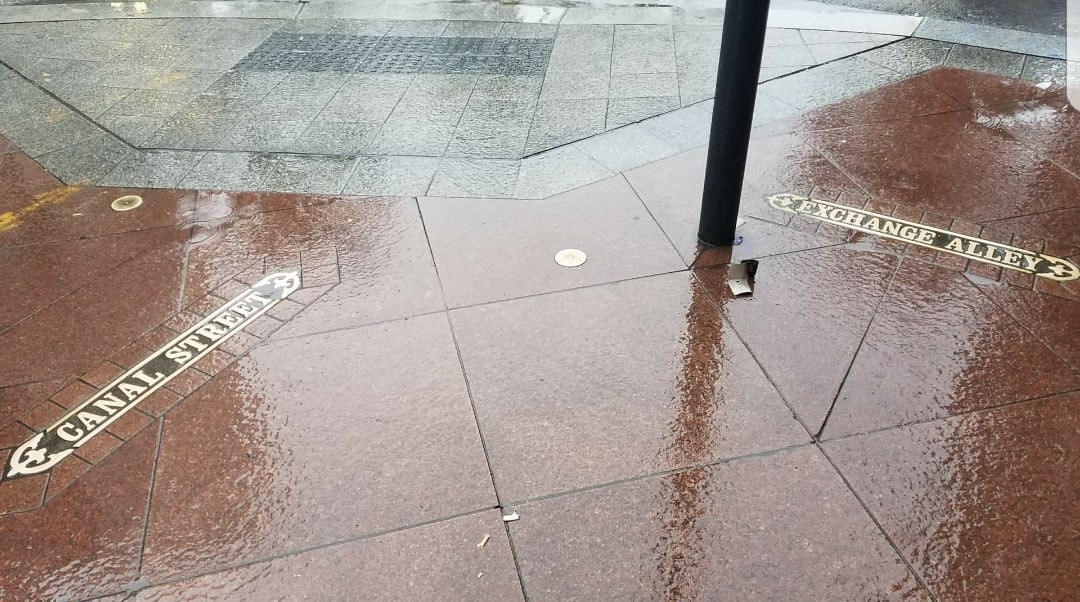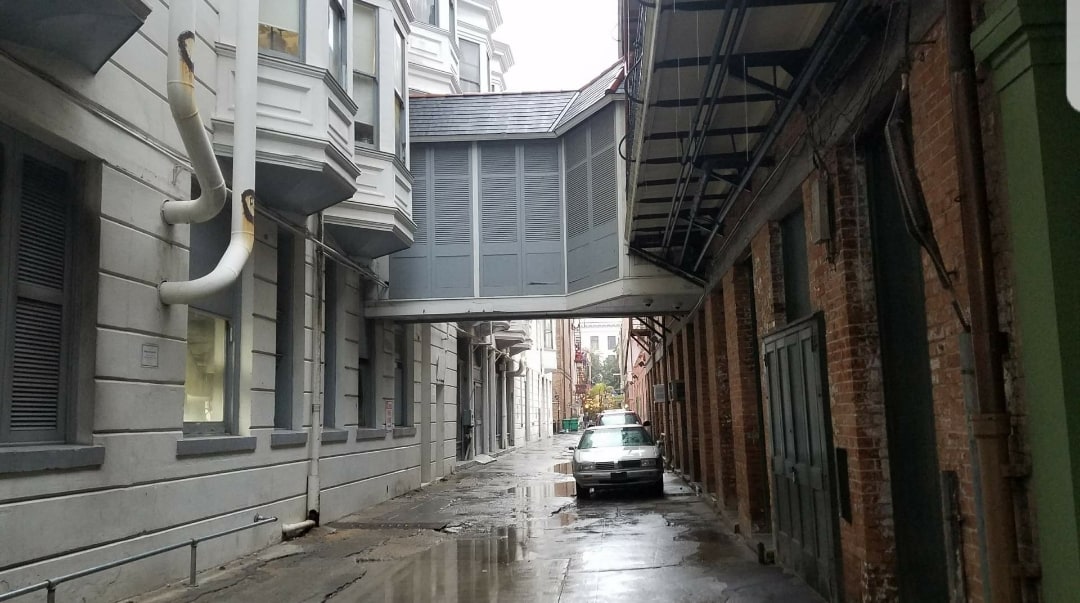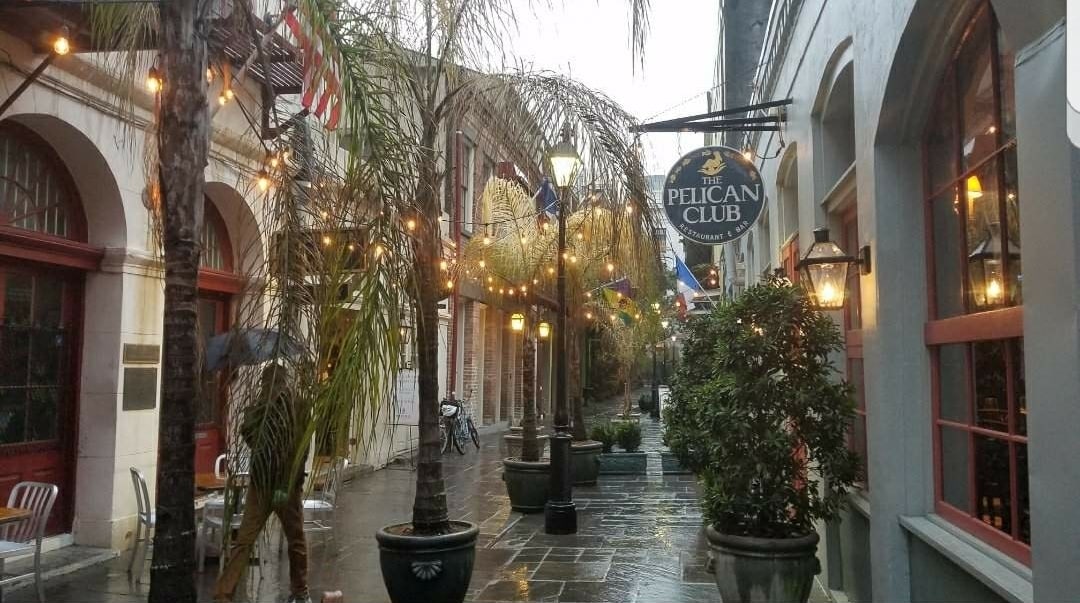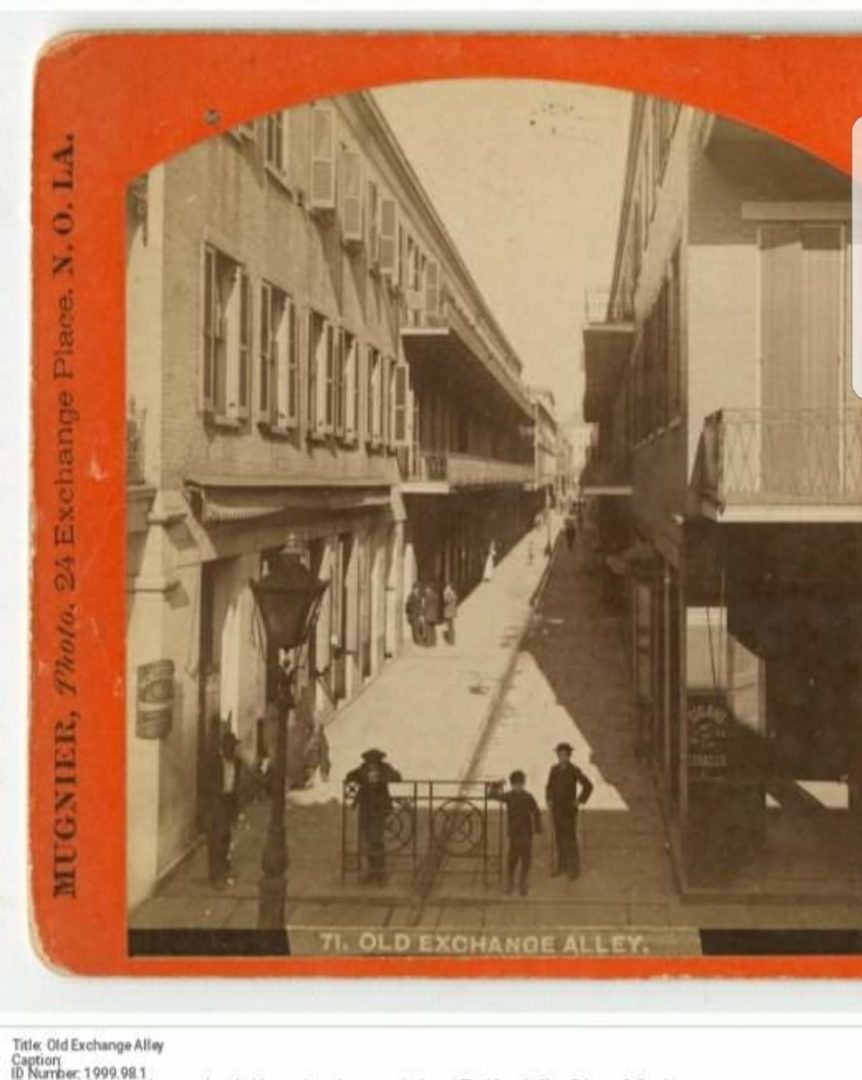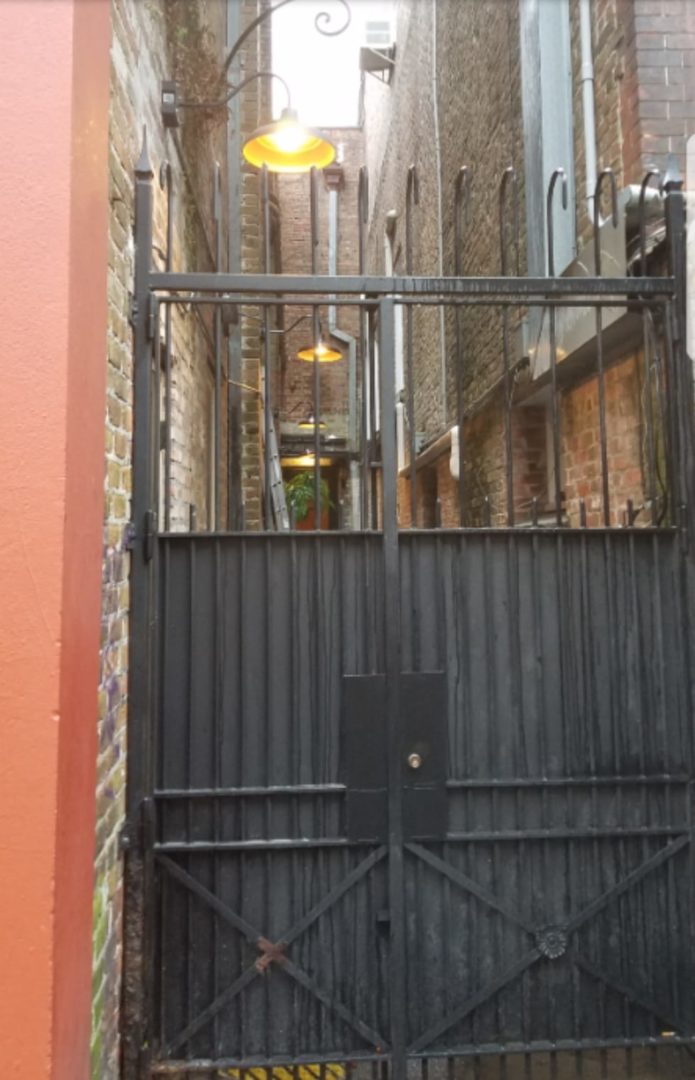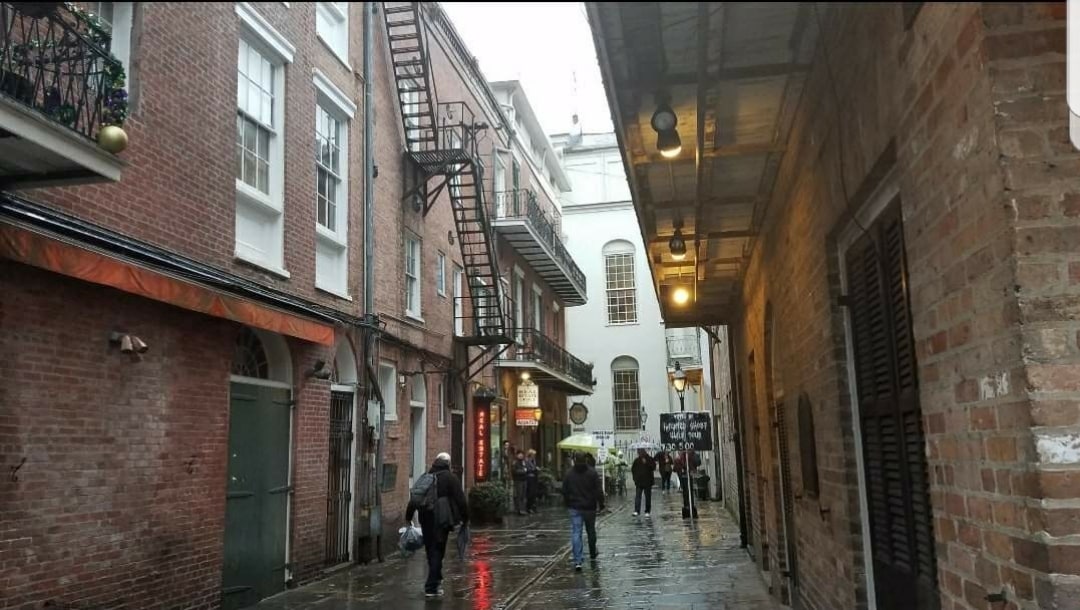Before the Civil War, exchanges were some of the most important buildings in American cities – particularly a port city like New Orleans. Here’s how local historian, Richard Campanella describes them in a piece he authored for the Preservation Resource Center of New Orleans:
“They were essentially places where people met to conduct business. But because the assembled parties usually had other needs and desires — for banking and legal services, reading rooms and studies, lodging, recreation, entertainment, victuals and libations — exchanges accommodated a much wider range of programming.
Entrepreneurs created ornate multi-use, multi-service “shared spaces” with sundry amenities catering to itinerant businessmen, and as such, exchanges became key nodes in cities’ social and economic geography.
Most of the more opulent hotels in antebellum New Orleans, such as the St. Charles and St. Louis, billed themselves as exchanges — roughly the equivalent of modern conference hotels — as did many “coffee houses” (saloons).”
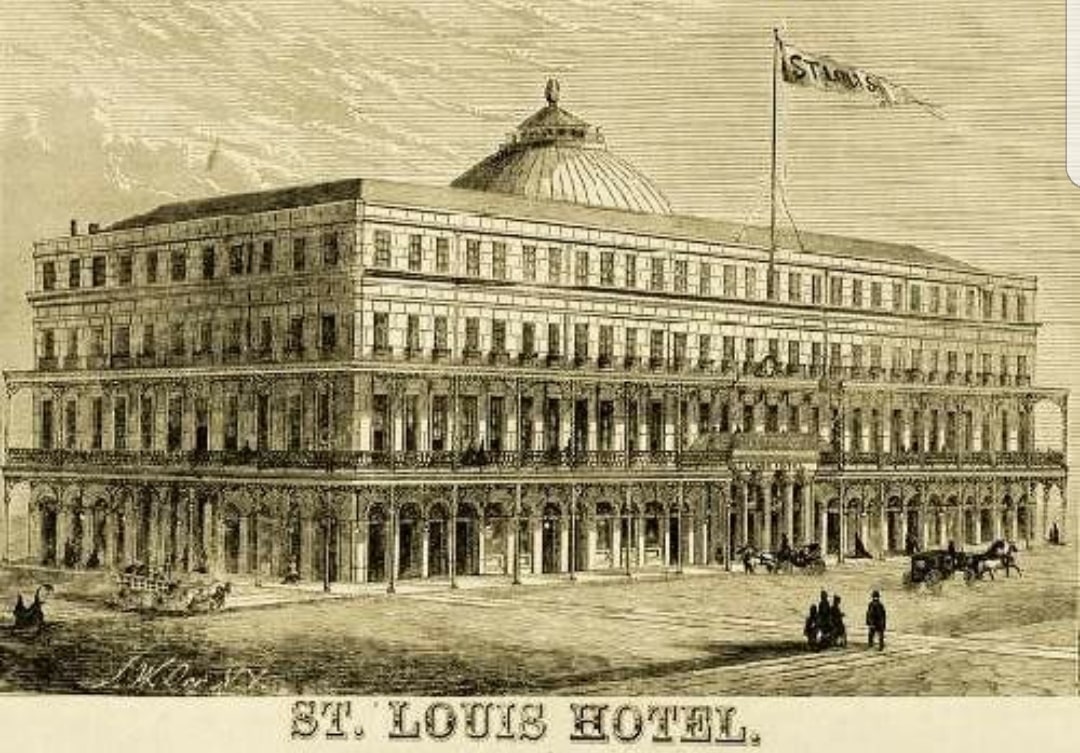
A passageway to what?
Exchange Passage – today known as Exchange Alley for a single block, before switching to Exchange Place thereafter – was created in 1831 as a small street in the French Quarter. Not a part of Bienville and Pauger’s original plan for the city — which was laid out more than a century earlier — Exchange Passage became a route between two of these important 19th-century exchanges.
At the time of the passage’s founding, New Orleans was said to have one of the highest occurrences of duels in the world, and young, wealthy men would flock to Exchange Passage to study fencing with the masters who worked on the street. But shouts of “En garde!” were soon replaced by murmurs of, “Can you spare a nickel?” as the destitute held court and the fencers took their studies to other parts of the city.
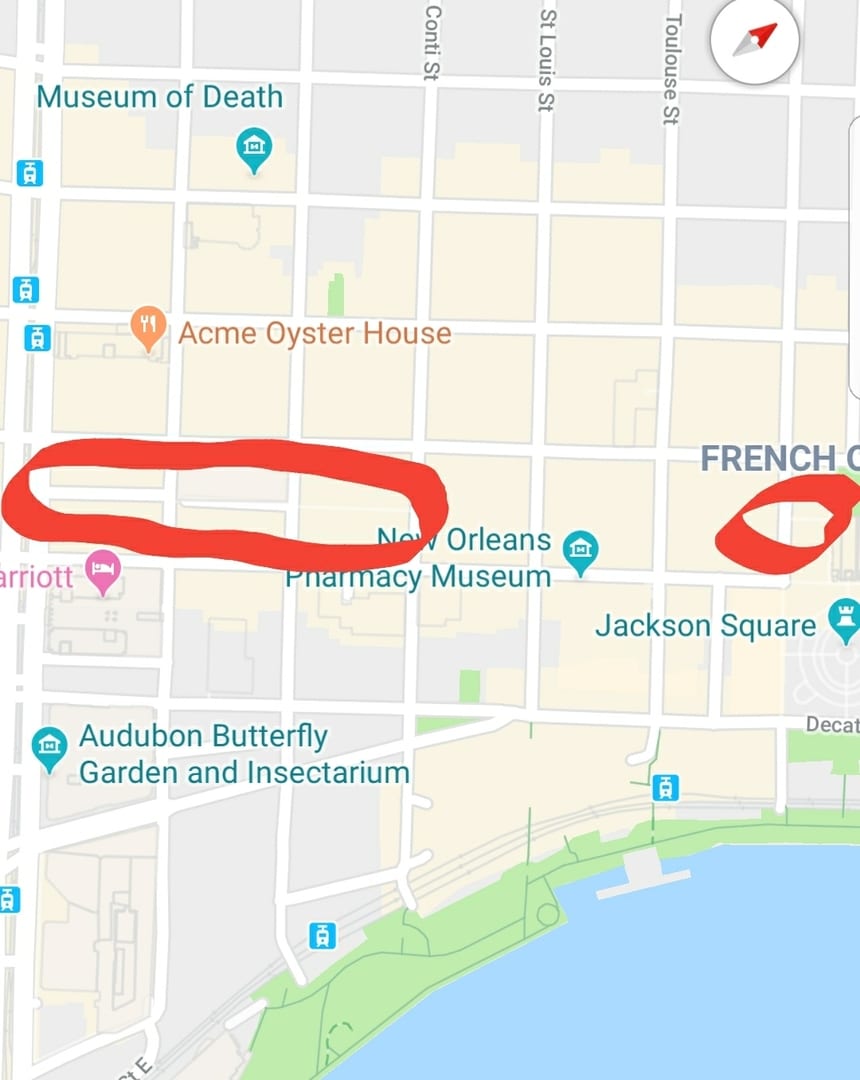
As you can see on the map, above, Exchange Alley runs into Canal Street, which is where – on an overcast day — I made a right to begin my exploration of this historic thoroughfare.
Today, the narrow road, used by the occasional garbage truck or lost motorist begins, humbly, between a Popeyes Chicken and a VooDoo Mart advertising a 24-hour ATM. But it wasn’t always so humble.
As Anglo-American influence grew and challenged Creole dominance in 19th century New Orleans, banker and merchant, Samuel Jarvis Peters, thought it would be savvy to build an exchange closer to Canal Street (Canal being the dividing line between the city’s two factions, with Creoles on the French Quarter side and Anglo-Americans on the CBD/Uptown side). He hoped this would help shift economic activity toward the Anglo-American portion of the city.
Thus, the “Merchants Exchange” was commissioned on Royal Street (at what is now 124-132 Royal) in 1835, and Exchange Passage was an oft-used back entrance into the building. The architect was none other than James Gallier, Sr., the Irishman also responsible for Gallier Hall, the Pontalba Buildings, St. Charles Hotel, and Government Street Presbyterian Church.
The exterior of Exchanges were often ornate affairs, but it’s said — due to space limitations — the facade of the Merchants Exchange was left relatively plain, designed in a Greek Classical style. The interior, however, according to Campanella, was anything but plain:
“What awaited inside would astound the visitor: a spacious rotunda uniting the two wings, topped with a stunning dome and florid skylight. Architectural historian Samuel Wilson Jr. described it as “one of the first great monumental interior spaces ever seen in New Orleans,” a soaring atrium bathed in natural light surrounding by walls with towering pilasters and Corinthian capitals.
The Merchants’ Exchange would host a head-spinning array of uses, programs and occupants. In today’s parlance, it was “shared space: flexible public space held in the private domain for multiple users day and night.”
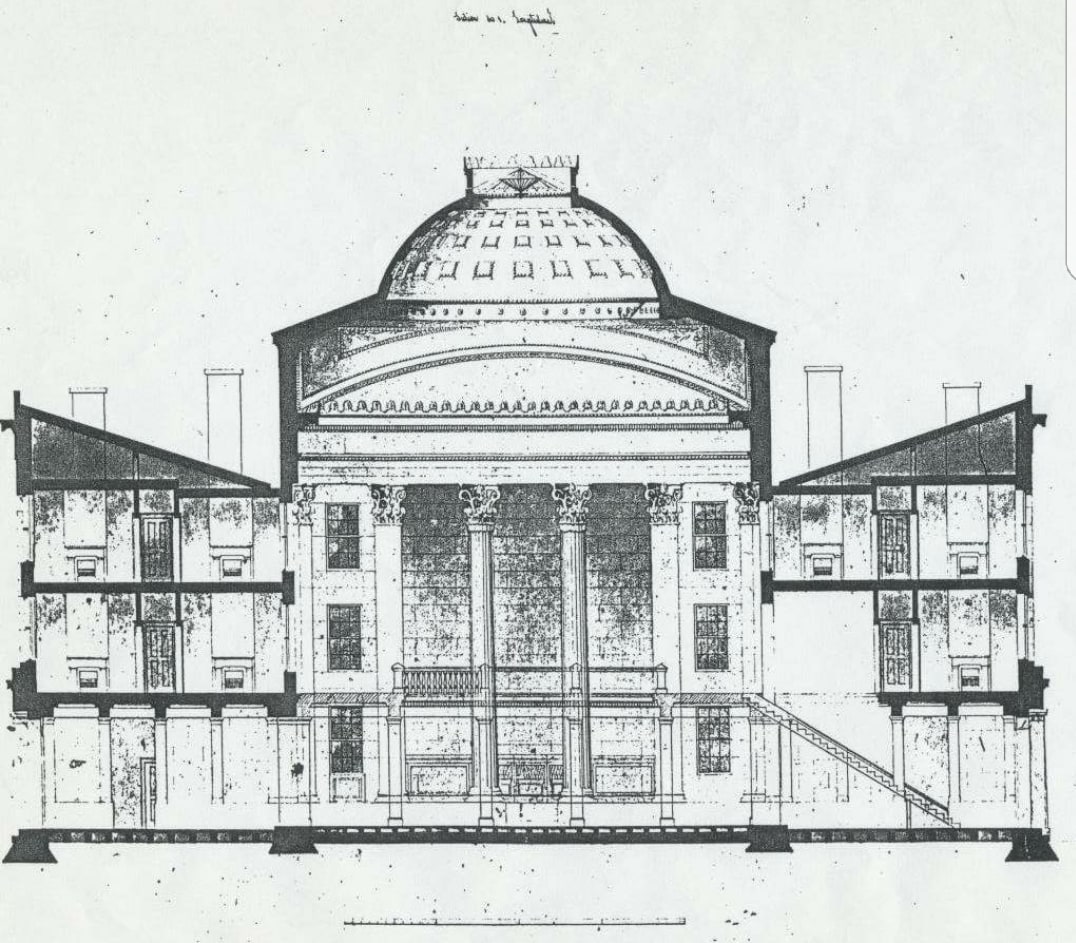
There were auction rooms, meeting areas, trading floors, a post office, and a barroom which made a killing off all the foot traffic the other activities in the building generated. For $10 per year, patrons had access to the second-floor reading room “stocked with the latest tomes and newspapers,” and two bulletin boards displaying ship information as well as the most important news of the day.
Commerce — on which exchanges were dependent — was slowed because of the blockades of the Civil War, as well as the collapse of the South’s slave-based economy once the war ended. The building wasn’t destroyed until a fire ravaged it in 1960, resulting in its demolition shortly after. As I bike around the building to its front side on Royal Street (the wrong way on a one-way, I know!) I see the historic space is now a bustling Wyndham Hotel.
A vibrant thoroughfare
Back on Exchange Place, I crossed Iberville Street (known as Custom House Street, on the map from earlier), and our alley takes a slight jog to the right. I arrive at a chain-link fence with a door-sized gap small enough to discourage motorists, but big enough to, if not encourage, at least to make pedestrian use possible. The road is more narrow than it was a block earlier, but it is similarly used as a place for Royal Street establishments – in this case, the Hotel Monteleone – to store their trash. A pedestrian walkway, possibly now out of use, crosses above me, and a series of parked cars, entering from upcoming Bienville Street, line the right side of the narrow passageway.
So far, Exchange Place has seemed a dirty, smelly route of convenience, rather than the vibrant route of choice for visitors and businessmen (especially — as I walked further into the Quarter — Creole businessmen) in the mid-1800s.
As I crossed Bienville Street, however, I could feel a liveliness return to the passage. The colorful signs of restaurants, bars, art shops, and museums lined both sides of the small alleyway. The smell of boudin and sweet potato biscuits filled the street and I stepped into Green Goddess — which I correctly assumed was the source of the scent — for lunch
After a really good Cuban sandwich ((Hawaiian Volcanic Black Salt slow roasted pork, finocchiona salami, manchego cheese, roasted pineapples, creole pickles, pressed and dressed with garlic aioli and creole mustard, oh my!), I walked toward Conti Street, lorded over by the hulking Louisiana Supreme Court building. I passed the Michalopoulos gallery and the Pelican Club bar and restaurant, whose white tablecloths and black-tie employees reminded me of the upscale 19th-century establishments I had been reading about. I passed by plants and tables lining the tiled pedestrian mall, as well as a cigar shop, street painters, and a charming showroom and workshop for Bevolo Gas & Electric Lights.
When I arrived at Conti, cars and pedicabbers zipped through the shadow of the Supreme Court. As can be seen in the 1863 map, Exchange Passage once continued through to the next street, but the court’s was built on top of the route in 1910.
At the turn of the 20th century, the need to expand and modernize the court resulted in a plan to knock down and replace the Cabildo — the home of the state’s Supreme Court since the 1860s — and the adjacent Presbytere with a new, modern court building. Thankfully, public outcry stopped that from happening.
The next potential target for the site was the old, St. Louis Exchange Hotel (we’ll get to this extraordinary building in a moment), but the commission eventually settled on one block upriver, directly on top of Exchange Passage’s path.
At the time, this section of the alley was said to be abuzz with legal and political offices falling into disrepair. A 1906 edition of the periodical, Architectural Art and Allies, reported, “In 1903, when the commission began purchasing or expropriating the properties, the buildings were dark, deteriorated, and tenement-like, and some saw the clearing of this land and the erection of a grand edifice as a means of ‘redeeming a neighborhood.”
Many disagreed, however, seeing it as an affront to the Quarter’s quaintness, as well as to New Orleans’ remarkable history. In June 1903, as the demolitions were taking place, the Daily Picayune published an editorial mourning the loss of the square as “one of the most historic sites in New Orleans. It is the very heart of the Vieux Carré … and while still palpitant with memories of the pioneer bravery and colonial splendor, it must be torn to pieces that progress may continue its onward march.”
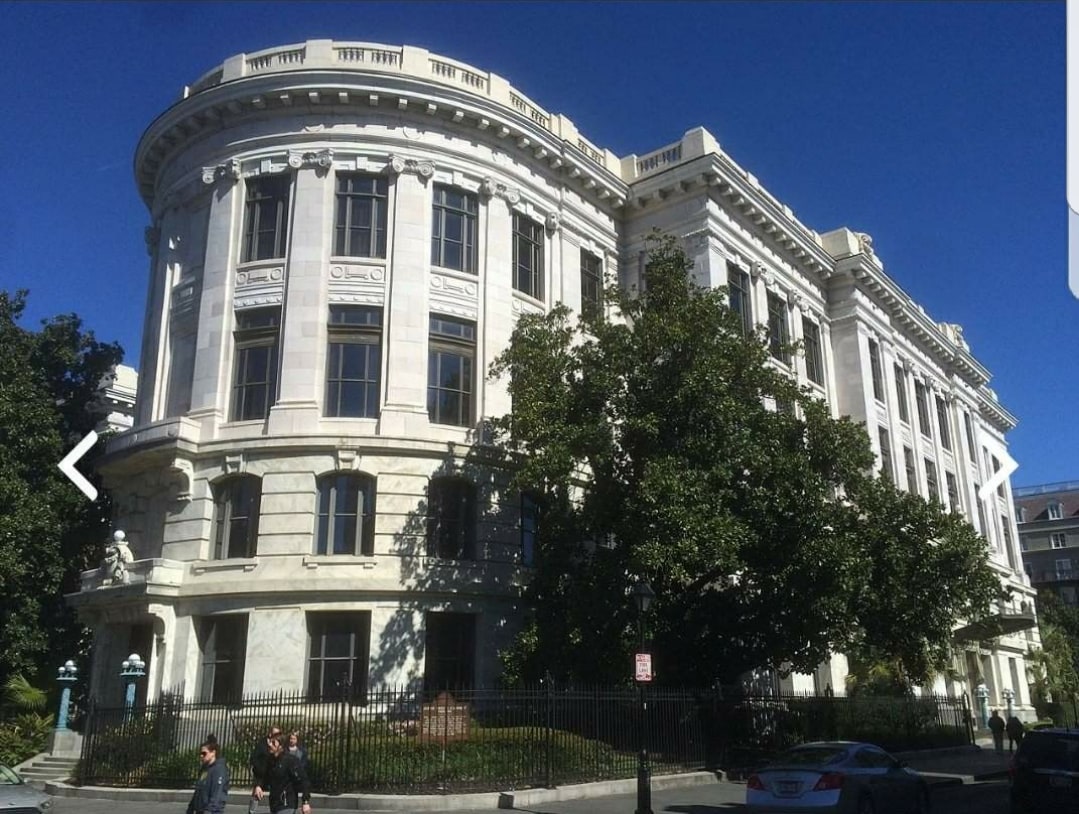
Approaching an icon
But just because this is where Exchange Place meets its official, modern-day end, doesn’t mean it’s where my journey needed to halt. I walked around the massive courthouse to pick up where Exchange Passage would have been on the next street, St. Louis Street. Here — according to John Chase’s book, “Frenchmen, Desire, Goodchildren: … and Other Streets of New Orleans” — is where pedestrians would have encountered the street’s most vibrant “attractions.”
The author explains that, at this corner, a man hawked “a strange new-fangled beverage called beer,” and that for quite some time, this was the only place in New Orleans to get it! (I would have spent a lot of time on this corner.)
This corner of Exchange Passage and St. Louis Street also hosted Charles Hicks’ cockpit, where he famously “staged hotly contested cockfights.”
But Campanella, in another piece, describes the main attraction:
“One of the best-known exchanges in the early 1800s had so many uses and owners that just about everyone referred to it differently. Located at what is now 501 Chartres, the enterprise started as Tremoulet’s New Exchange Coffee House and became Maspero’s Exchange in 1814, then Elkin’s Exchange after Maspero died in 1822.
“John Hewlett renamed it Hewlett’s Exchange by 1826, although the enterprise also went by the name, Exchange, or New Exchange Coffee House, Hewlett’s Coffee House, or, for Francophones, La Bourse de Hewlett. The two-story corner structure boasted, behind its Venetian privacy screens, a 19-foot-high ceiling, four chandeliers, framed maps and oil paintings (described by one Northerner as “licentious”), wood-and-marble finishing, an enormous bar with French glassware, and billiards and gambling tables upstairs.
“Hewlett’s Exchange buzzed with trilingual auctioning activity for everything from ships to houses to land to sugar kettles to people legally changed hands. The city’s seven auctioneers worked the block on a rotating schedule, every day except Sunday, and it was likely here that a young Abraham Lincoln witnessed a slave auction on his 1828-1831 flatboat visits to New Orleans.”
In 1835, New Orleans made the questionable decision to split into three separate municipalities. This further intensified the rivalry between Anglo and Creole New Orleanians, because now they were competing separately for investment, instead of together as one city. When the Anglo-Americans built the St. Charles Hotel – one of the first of the great hotels in the United States – upriver of Canal Street, with all the amenities one would find in a multi-functional Exchange, the Creoles responded by building the St. Louis Hotel – originally called The Exchange Hotel — on this corner of Exchange Passage and St. Louis.
The hotel housed an exchange inside – on the same site as so many before it – and was given the name “The City Exchange.” The hotel was the center of social activities for Creoles and visiting Europeans. It was meant to be a creole place; a place for aristocrats to eat, drink, make love, and buy and sell commodities. Businessmen of the French Quarter would go to register sales and consummate business here, and it was also the site of many balls and banquets.
Predictably, and unfortunately, this was the site of many kinds of business. Walking into the hotel in the 19th century, one would have seen a large auction block – set under the building’s grand rotunda — where slaves were sold. Those that weren’t sold were held in slave pens around the French Quarter until the next auction. Joseph Le Carpentier was an auctioneer at the exchange and, as an example of how lucrative this business could be, in 1840, he sold slaves at a value equivalent to what would have been more than $1.5 million in 2015 dollars.
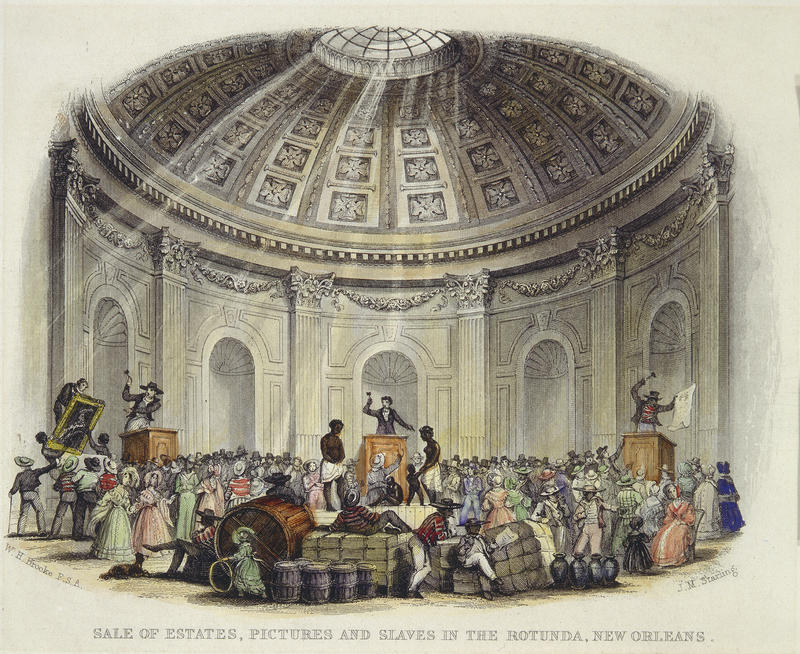
Courtesy of Sale of Estates, Pictures and Slaves in the Rotunda, New Orleans; by William Henry Brooke, engraver; engraving with watercolor from The Slave States of America, vol. 1; London: Fisher and Son, 1842
The hotel remained a central hub of life and business until it was captured by Union soldiers in 1862. For the remainder of the Civil War it served as a Union hospital, destroying much of its grandeur and elegance. From 1865 – 1867, during Reconstruction, the building was sold to the state of Louisiana and became its de facto capital. After reconstruction, the building was sold from one owner to the next, serving either as a hotel or a bank, until the hurricane of 1915 left it in a heap of rubble.
Over the years, Exchange Passage had accrued an impressive maze of bars. A recurring joke was that the street had gotten its name because men who frequented them were exchanging a successful future for a decadent present.
After much discussion among New Orleanians about restoring the charm and prominence of the French Quarter, the hotel was rebuilt in 1960, now as the Royal Orleans. The 20th-century hotel encompassed the same European grand design as the old one, including the “exact drawings of the remaining stone arches … and [the] exact duplicates of the Spanish wrought iron railings” which had once graced the hotel. In 1986 Omni Hotels of Dallas, Texas, took over the hotel’s lease and named it the Omni Royal Orleans.
It began to drizzle as I approached the enormous hotel, stretching the entire length of St. Louis Street, between Chartres and Royal. I had biked by it countless times over the years, but today I took the time to admire the ornate gas lanterns hanging from the underside of the outer balcony, beside slim green columns spaced out every few feet. The sheer number of windows and rooms was incredible.
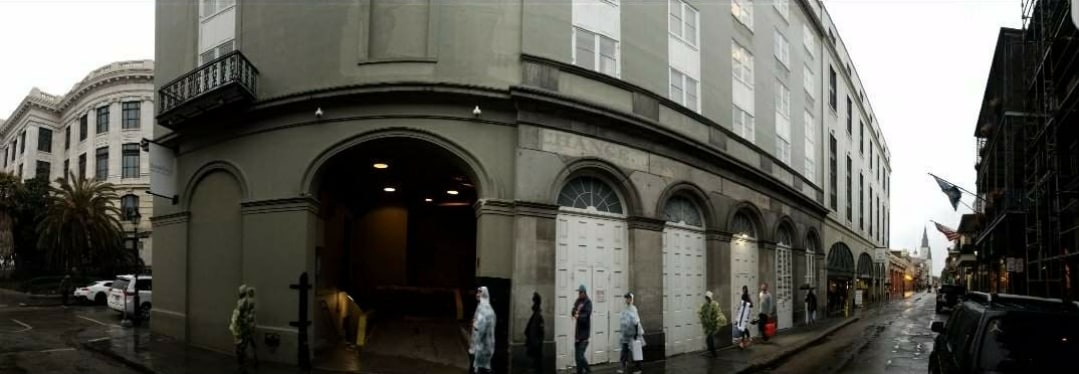
Beginning in the 1830s, Exchange Passage would pass directly through the St. Louis Hotel and, conveniently, its bar. Chase writes that this hotel bar was the finest in the city at the time, and he revealed an innovation that took place there.
“The real business in the exchanges – the auctioneering,” he wrote, “took place between the hours of noon and three o’clock. There simply wasn’t time to stop at a bar, go home for lunch, and get back to business. The St. Louis Hotel Bar would give free lunch – soups, vegetables, a choice of meats and bread – to any customer who came in for “a toddy.” This idea spread throughout New Orleans, and across America, resulting in bars competing for customers through the quality of their free lunch, — a practice that lasted all the way until Prohibition.
I walked through the immaculate lobby, shining with a spectacular chandelier and golden lanterns holding – unnecessarily – more candles. Beautiful paintings line the wall, one of which tells the history of the hotel.
I walk into the modern-day hotel bar, Touche Bar, which is now off to the left of what would have been Exchange Passage, and order a hot toddy. I am dismayed to learn it no longer comes with a free lunch, but I do my best to keep calm.
Taking care of business
From the bar, Exchange Passage would have continued through the hotel and out the back into Improvement Bank (which became Citizens Bank), and then out of the bank onto Toulouse Street. But this path no longer exists, so after my drink, I walk down Royal Street — teeming with day-time shoppers and tourists — make a right on Toulouse and imagine where the path might have gone from here.
Chase writes that continuing on Exchange Passage from Toulouse was tricky, but that historians suggest “surmising businessmen” may have hopped a fence to forge ahead. In the 1840s, there was talk of the First Municipality (the governing authority for the French Quarter when — as I described earlier — the city split into three) buying property and clearing a right-of-way for Exchange Passage to the next street, St. Peter Street. But that never happened, and the alley never achieved more than a dotted line on maps between Toulouse and St. Peter.
I walked up Chartres to St. Peter Street and back to the middle of the block. I was thrilled to find a small alleyway behind a fence I imagine could have been the remnants of Exchange Passage.
Then, to my right, I saw a street that certainly was. Now called Cabildo Alley, this final section of Exchange Passage extends one block from St. Peter Street to Pirates Alley (which, when it was formed, as a path around the St. Louis Cathedral garden in 1831, was referred to as North Orleans Street).
The Cabildo, just on the other side of Cabildo Alley, had a prison attached. Unlike on the previous block, the First Municipality agreed to accommodate the young street. The fence of the prison was moved back to make room for this last stretch of road, allowing men to walk directly to the Cabildo’s courthouse, in order to more easily handle business.
I walked up the Cabildo Alley’s brick walkway, dodging vacationers on a ghost tour, and briefly considered grabbing a drink at Pirate’s Alley – the bar with the same name as the street – before the length of the line discouraged me. I reached the Cabildo, made a right onto Pirate’s Alley and resurfaced in Jackson Square — packed with artists, palm readers, and picture-taking tourists — satisfied with having done my best to follow the path of many a 19th century Creole businessman.
But as I walked back to my bike on Canal Street, I couldn’t help but wonder. Walking through buildings? Jumping fences? Maneuvering around prisons? Why not just walk on Chartres or Royal streets, only half a block on either side? As with so many questions, Chase has an interesting explanation:
“Chartres and Royal were the two great shopping streets of the First Municipality. Women were there! Women buying bonnets and parasols and lace and calico, etc., etc. Women are wonderful, the men of business reasoned, but they didn’t mix with business. Exchange Passage was a stag street hemmed in by petticoats.”
Fair enough. According to the Daily Picayune, letters going to the Merchant Exchange post office that were addressed to (most) men were delivered to the Exchange Passage entrance, while mail addressed to women were delivered through the Royal Street side.
Shortly after Prohibition, however, things changed. A reporter for the Item-Tribune surveyed the situation in 1934, during the Great Depression, and a barkeep proclaimed the following to him:
“A woman, she was an unusual sight in the alley — everyone used to leave the bar and go outside and look at her when one passed. But…the way it is now, there’s proportionally as many women as men who come in at night to take a little quiet glass of beer or something stronger.
We used to be the poor man’s club, but now we’re the poor woman’s club, too, and there ain’t too many rich men or women’s clubs no more. Not where you can get ten ounces for a nickel, no sir.”
Out of favor
As I walked back toward my bike, I flipped through my phone and read about how these giant multi-purpose exchanges fell out of favor. As I mentioned earlier, a lot of this had to do with the struggles of Southern commerce, in general, during and after the Civil War.
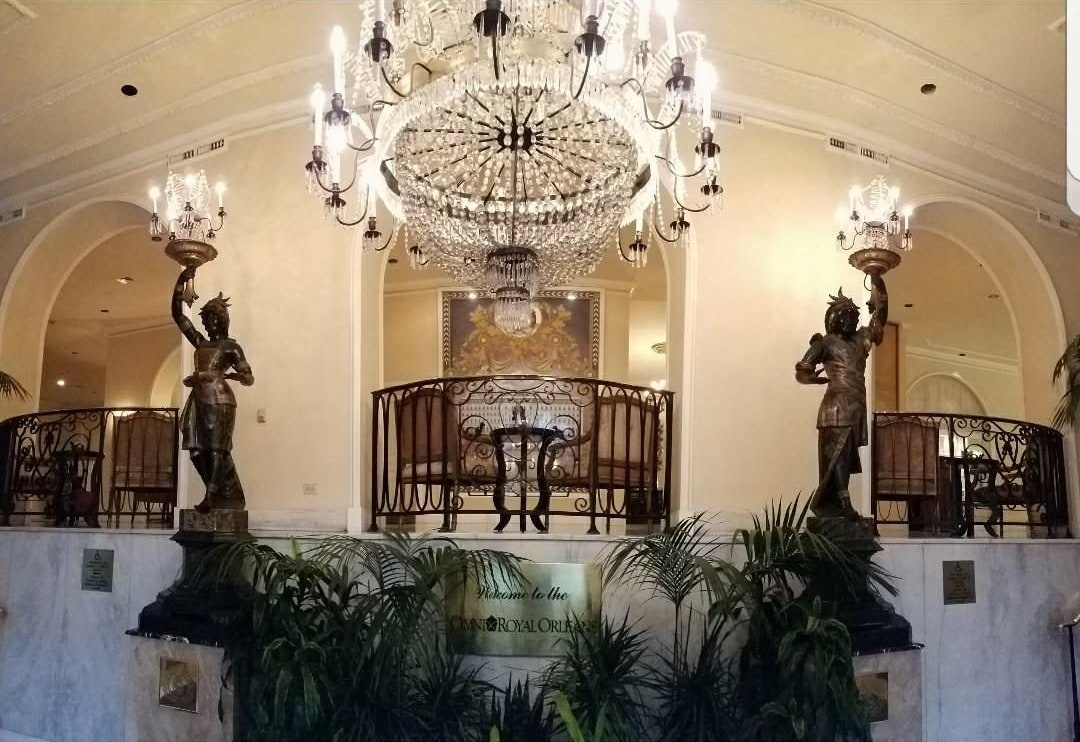
Their decline, however, was also due to their success. As the economy rebounded, many industries decided they wanted their own exchange — rather than being part of more general establishments. The Cotton Exchange, established in 1871, the Produce Exchange in 1880, the Louisiana Sugar Exchange in 1883, and a Stock Exchange in 1906 are just a few of many examples.
As the 20th century progressed, the city would invest quite a bit of money to make Exchange Place less a place for locals to drink and more a place for tourists to shop. But taking a walk down this narrow street on a weekday afternoon was a reminder of the incredible commercial success — but also the ethnic tension and racial atrocities — of 19th century New Orleans.


